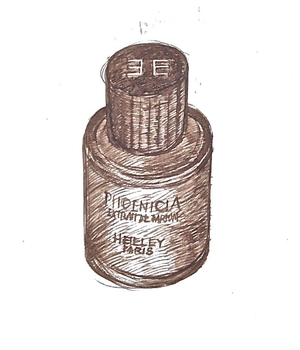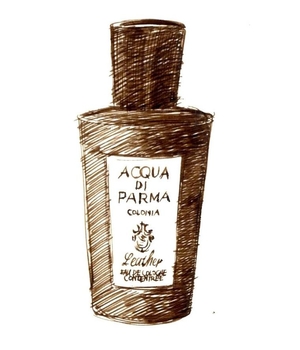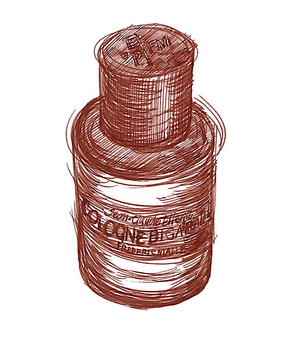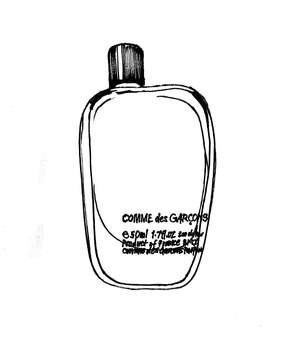Tagged With ‘cedarwood’
Heeley
Menthe Fraîche
31 March, 2017
The mouth-watering smell of mint might be one of the most refreshing scents in the natural world, but it’s a bugger to use in perfumery, for the simple fact that toothpaste manufacturers got there first. Mint has been the most popular flavour for toothpaste since the early 20th century, so it’s a brave perfumer who decides to make it the main ingredient in a scent.
Enter the Yorkshire-born, Paris-based scentorialist James Heeley, who in 2004 released Menthe Fraîche, a bold and rather brilliant fragrance that puts mint firmly on centre stage – and got away with it without making it smell like mouthwash.
Menthe Fraîche smells fantastically minty by dint of a clever combination of natural and synthetic ingredients that reinforce and support each other in a way that simply spraying mint-oil on yourself never would. James Heeley notes that ‘Menthe Fraîche was a collaboration with a laboratory in Grasse, inspired by the smell of Corscian mint underfoot. It includes bergamot, a lot of cedarwood, fir balsam and white musk. It’s fresh without being overpoweringly minty.’ It includes both spearmint and the colder-smelling peppermint, as well as hints of green tea.
Though sadly it doesn’t last very long on the skin, Menthe Fraîche does keep going longer than some reviewers have claimed; I can still smell it a couple of hours after spraying it on, but then it’s a pleasure to reapply. And it is, after all, a cologne, something you’d use to freshen up on a hot summer’s day, rather than the kind of heavyweight perfume you might long for on a cold winter evening.
Created in collaboration with the professional perfumer David Maruitte, it also has a raft of synthetics, detailed by Chandler Burr in a typically excellent article for the New York Times, which you can read here. In a variation on the theme of art concealing art, Menthe Fraîche smells so wonderfully fresh and natural precisely because of the synthetic molecules in its make-up, not despite them – and that for me is one of the wonders of professional perfumery.
Heeley
Phoenicia
24 August, 2015
 Though there’s some dispute about its exact origins, the word ‘perfume’ most likely derives from ‘fumes from a substance being burned’, so you could say that Phoenicia, the latest fragrance from Yorkshire-born, Brussels-based perfumer James Heeley goes back to perfume’s roots.
Though there’s some dispute about its exact origins, the word ‘perfume’ most likely derives from ‘fumes from a substance being burned’, so you could say that Phoenicia, the latest fragrance from Yorkshire-born, Brussels-based perfumer James Heeley goes back to perfume’s roots.
The name refers to the ancient civilisation that flourished in the eastern Mediterranean around 1000BC, but Phoenicia’s smell is instantly evocative of childhood bonfires, just as his earlier L’Amandière evokes an almond orchard in spring.
‘I loved the way my hair smelled after a bonfire,’ Heeley recalls, and he’s captured the memory using a mixture of cedarwood, oud, smoky birchwood and vetiver.
Luckily there’s more to Phoenicia than smoke. ‘I’ve always loved the concrete of labdanum ciste,’ Heeley says (the densest refined extract from the fragrant Mediterranean shrub Cistus ladanifer), ‘which has a slight smell of dates or prunes.’ Adding this to the formula gives Phoenicia an attractive hint of dried-fruit sweetness, which balances the smokiness is a very attractive way. It certainly lights my fire.
Acqua di Parma
Colonia Leather
26 February, 2015
 The smell of leather is one of the staples of men’s fragrances. It has an interesting history, too, since at least one of the roots of modern perfumery can be followed back to the perfumed-leather gloves that became fashionable from the sixteenth century on.
The smell of leather is one of the staples of men’s fragrances. It has an interesting history, too, since at least one of the roots of modern perfumery can be followed back to the perfumed-leather gloves that became fashionable from the sixteenth century on.
Some ‘leather’ fragrances are more successful than others, Chanel’s powerful and historic Cuir de Russie being one of the best. But until the launch of Colonia Leather in May 2014 I’d never come across a perfume that really captured clean new leather’s comfortingly aromatic smell.
I have to admit that this came as something of a surprise, as I’m not a great fan of the other perfumes in the Acqua di Parma range. I can recognise their quality, and I love their packaging, but their combination of lemon and rose just doesn’t do it for me – the rose seems just too feminine a counterpart to the freshness of the classic citrusy eau-de-cologne.
So I could hardly believe my nose when I first sprayed Colonia Leather on. Yes, it contains a definite hint of the Acqua di Colonia signature rose-cologne smell, but that’s quickly overlaid by a beautifully smooth, refined leather smell, like the finest fresh kidskin gloves, or an unjustifiably expensive suede jacket from Hermès. Though it’s not especially strong, its gentle scent stays on the skin for a good half day or more, even if I find it hard to smell on myself after an hour or so.
How such an authentically leathery fragrance is done is beyond me, though it does contain at least one of the classic ingredients of ‘leather’ perfumes, rectified birch tar, which is also used in Cuir de Russie. I’ve pointed out before that a list of ingredients is about as useful in describing a perfume as a list of words in describing a Shakespeare sonnet, but for those who would like to know here are some of the other things in the formula: Sicilian lemon, Brazilian orange oil, raspberry, rose, honeysuckle, Paraguayan petitgrain (made from the twigs of orange trees), ‘red’ thyme, cedarwood, cistus, guaic wood and olibanum.
So who was behind this marvellous scent? As usual there’s no mention anywhere on the Acqua di Parma website or in its marketing material, but I think Colonia Leather’s creator deserves more credit than that. So please take a bow François Demachy, the French perfumer, formerly at Chanel, who has been the ‘director of olfactory development’ at Christian Dior since 2006.
(If you’re wondering, incidentally, what Dior’s head perfumer is doing moonlighting for Acqua di Parma, the answer is that both companies are owned by the luxury-goods conglomerate LVMH, and Demachy also has oversight of its other perfume brands. And as it happens Colonia Leather isn’t his first perfume for Acqua di Parma; he also created Colonia Intensa, which was launched back in 2007.)
At £150 for 100ml Colonia Leather is a lot more expensive than the other fragrances in the Acqua di Parma range, and for now (2014) it’s only available from Harrods, but it’s really worth going to smell, even if you can’t justify spending quite so much on a single bottle of perfume.
Frederic Malle
Cologne Bigarade
10 January, 2015
 Every morning for my breakfast I have tea, toast and home-made marmalade. It’s one of my favourite things, and I love the bittersweet smell of Seville oranges, which only appear in the shops for a couple of weeks around this time of the year.
Every morning for my breakfast I have tea, toast and home-made marmalade. It’s one of my favourite things, and I love the bittersweet smell of Seville oranges, which only appear in the shops for a couple of weeks around this time of the year.
In fact as I sit here writing this post in January, Roy is busy cooking marmalade next door, and the powerful odour of bitter orange (known as bigarade in French) is suffusing the house from kitchen to attic.
So it could hardly be a better time to review Cologne Bigarade, created by the perfumer Jean-Claude Ellena for the French fragrance curator and marketeer, Frédéric Malle (nephew of the film director Louis Malle). Launched in 2001, it was one of the first of the Editions de Parfums Frédéric Malle, and to my mind it’s one of the most immediately appealing and easy to enjoy.
On first – I was going to say ‘glance’, but I suppose I should say ‘spritz’, it smells like a simple but high-quality natural scent, with the exact mix of sweet green freshness and slight bitterness that you get from orange peel and its bitter pith.
You could, I guess, just bottle Seville-orange extract and have done with it – and apparently Jean-Claude Ellena did commission a special new essence for this scent, obtained by molecular extraction. But like all good perfumes Bigarade Cologne is ultimately a clever recreation of what seems, on the surface, like a simple natural scent, using a careful balance of other ingredients to enhance and support the main ingredient.
In this case, Ellena has added a bit of hay and grass – or rather their synthesised essences – which makes the orange even fresher somehow, then subtly underpinned it with a little cedar-wood and rose, adding extra depth and staying-power. You could even say that these extra ingredients suggest the smell of the leaves and the twigs of orange trees, though perhaps that’s going too far.
(Actually, unless you concentrate very hard you can’t really smell them at all; but then we’re so suggestible when it comes to scents that once someone has told you that a particular ingredient is present, you’re more than likely to ‘smell’ it whether it’s actually there or not.)
To me Cologne Bigarade also has a very slight and not unpleasant sweatiness, which (from a short trip to the kitchen and back) is part of the authentic Seville orange smell. In perfume that faint sweatiness is often derived from cumin, and I wonder if there might be a touch of that classic curry spice here too.
Cologne Bigarade is not, perhaps, the most complex perfume on the market, but like most of Jean-Claude Ellena’s fragrances it’s rather more thoughtful and unusual than the general run. Given that he’s also the in-house perfumer for Hermès, it immediately made me think of Hermès’ classic Eau d’Orange Verte, which is also based on the scent of bitter oranges. Though that perfume was originally created by Françoise Caron in 1979, Ellena developed a new version in 2004 called Concentrée d’Orange Verte.
Eau d’Orange Verte is one of my all-time favourite fragrances, yet comparing them side by side, it smells sharper and fresher, but perhaps also slightly less interesting than Cologne Bigarade, which also seems to have much more staying power (a rare quality in a citrus-based cologne, though you can also find it in the fantastic sherbet-lemon Monsieur Balmain).
All the fragrances in the Editions de Parfums Frédéric Malle are expensive, and Cologne Bigarade is no exception, even if its packaging is extremely smart. The heavy, plain-glass bottle has a chunky black cap and comes in a slide-out, black foam-padded box, which in turn slides out (with some effort) of a scarlet card wrapper. If you have money to burn then there’s an even more expensive version called Bigarade Concentrée, which I’ve smelled as a sample and lasts even longer than Cologne Bigarade. The concentrated version also seems to have less of that faint sweatiness about it, which I suspect many people would prefer; I think I do too.
Either way, a fresh but unusual cologne is a wonderful thing to have, so full marks to Jean-Claude Ellena and Frédéric Malle for giving men something a bit different to wear. In a similar vein, though with a very different smell, is Malle’s Geranium Pour Monsieur, which I hope to be able to review before long; watch this space.
Comme des Garçons
Eau de Parfum
12 November, 2014
 Christmas is coming, and as a long-standing fan of over-indulgence I’m thoroughly looking forward to getting fat on Christmas pudding with brandy butter, washed down with a large glass of Harvey’s Bristol Cream, ideally in front of a roaring log fire. Alternatively I could just blow my own socks off with a generous splash of Comme des Garçons’ delicious Eau de Parfum a.k.a. Christmas in a bottle.
Christmas is coming, and as a long-standing fan of over-indulgence I’m thoroughly looking forward to getting fat on Christmas pudding with brandy butter, washed down with a large glass of Harvey’s Bristol Cream, ideally in front of a roaring log fire. Alternatively I could just blow my own socks off with a generous splash of Comme des Garçons’ delicious Eau de Parfum a.k.a. Christmas in a bottle.
Launched in 1994, this was the Japanese cult fashion brand’s first foray into perfume, but if there was nothing unusual about that, it’s rare for a first perfume to make such a big impression. Partly it was the design of the bottle, a slightly egg-shaped oval with an off-centre cap and no obvious way to stand it up.
That might sound a bit annoying, but I think it’s one of the most stylish and sophisticated perfume-bottle designs of the last 20 years. Eccentric it may be, but Comme des Garçons founder Rei Kawakubo’s design is so sleek and refined that it makes most other perfume bottles look cheap and tawdry by comparison.
The Sniff Box is about the scent, though, and what a scent this is. Created by Derby-born perfumer Mark Buxton, it’s not for the shy or faint of heart, for this is one of those fragrances that carries everything (and everyone) before you. The first thing you smell is cloves – or rather clove oil: in fact this is a distinctly oily concoction, for among the other ingredients are nutmeg oil, cinnamon-bark oil, cardamom oil, geranium oil and coriander oil. To me it even feels slightly oily on the skin, which gives it an added touch of luxury and also sets it apart from the vast majority of alcohol-based fragrances.
With ingredients like those it could hardly be anything other than spicy, but Mark Buxton cleverly added a touch of the resinous, smoky smell of incense with cedarwood, labdanum and styrax. The result is wonderfully rich and strange, and though some people find it overpowering, to be overpowered like this is like drowning in a butt of Malmsey: what a way to go!